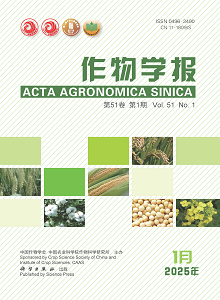利用rDNA和端粒重复序列鉴定马铃薯和茄子体细胞杂交种染色体丢失和重排
引用次数: 0
摘要
体细胞杂交是创造新种质的重要途径。体细胞杂种在原生质体再生过程中产生了大量的遗传变异。在本研究中,为了分析马铃薯和茄子体细胞杂种的染色体组成和变异,使用rDNA和端粒重复序列作为FISH(荧光原位杂交)探针,并结合GISH(基因组原位杂交)。结果表明,体细胞杂种中存在重排染色体和双着丝粒染色体,重排染色体的部分来源于马铃薯和茄子2号染色体的端到端融合。重新排列的双着丝粒染色体的一个着丝粒来源于马铃薯,另一个来源于茄子。在体细胞杂种中丢失茄子5S rDNA位点以使体细胞杂种的rDNA均质化。本研究结果表明,马铃薯和茄子的体细胞杂交过程中染色体不稳定,容易导致体细胞杂交中的双着丝粒和染色体重排。体细胞杂种的染色体通过染色体重排、双着丝粒和rDNA均一化等多种途径趋于稳定。本文章由计算机程序翻译,如有差异,请以英文原文为准。
Identification of chromosome loss and rearrangement in potato and eggplant somatic hybrids by rDNA and telomere repeats
: Somatic hybridization is an important way to create new germplasm. Somatic hybrids produced plenty of genetic variation during protoplast regeneration. In this study, to analyze the chromosome composition and variation of potato and eggplant somatic hybrids, rDNAs and telomeric repeats were used as probes for FISH (fluorescence in situ hybridization), combined with GISH (Genomic in situ hybridization). The results showed that rearranged chromosomes and dicentric chromosomes existed in somatic hybrids, and the parts of the rearranged chromosomes was derived from the end-to-end fusion of potato and eggplant chromosomes 2. One centromere of the rearranged dicentric chromosomes was derived from potato and the other was from eggplant. Eggplant 5S rDNA sites were lost in somatic hybrids to homogenize the rDNA of somatic hybrids. The results of this study indicated that the chromosomes were unstable during the somatic hybridization of potato and eggplant, which can easily cause dicentric and chromosomal rearrangements in somatic hybrids. The chromosomes of somatic hybrids tended to be stable through various ways such as chromosome rearrangement, dicentric and rDNA homogenization.
求助全文
通过发布文献求助,成功后即可免费获取论文全文。
去求助
来源期刊

作物学报
Agricultural and Biological Sciences-Agronomy and Crop Science
CiteScore
1.70
自引率
0.00%
发文量
89
期刊介绍:
The major aims of AAS are to report the progresses in the disciplines of crop breeding, crop genetics, crop cultivation, crop physiology, ecology, biochemistry, germplasm resources, grain chemistry, grain storage and processing, bio-technology and biomathematics etc. mainly in China and abroad. AAS provides regular columns for Original papers, Reviews, and Research notes. The strict peer-review procedure guarantees the academic level and raises the reputation of the journal. The readership of AAS is for crop science researchers, students of agricultural colleges and universities, and persons with similar academic level.
 求助内容:
求助内容: 应助结果提醒方式:
应助结果提醒方式:


